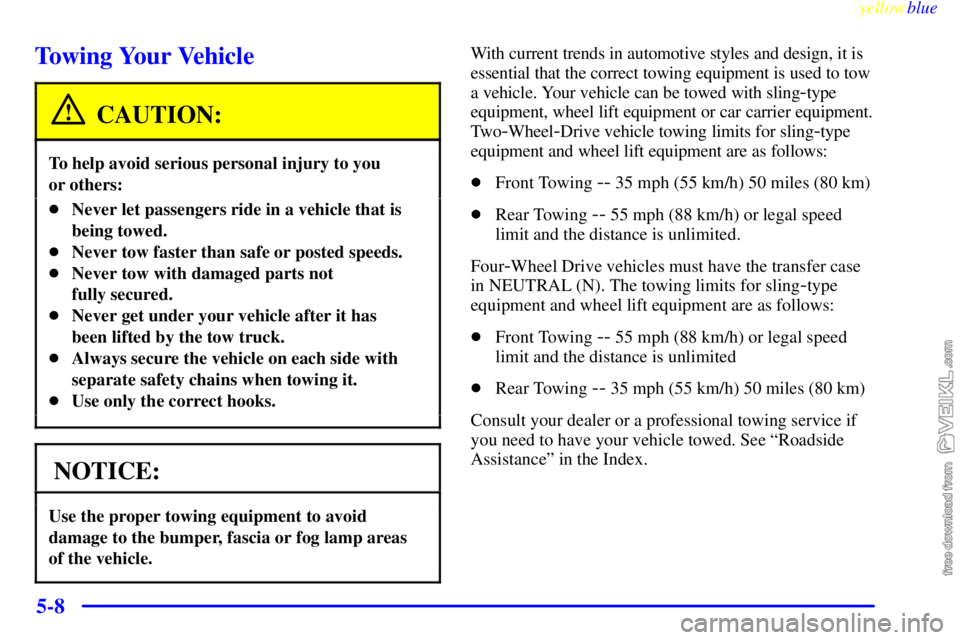Page 218 of 440
yellowblue
4-36
Winter DrivingHere are some tips for winter driving:
�Have your vehicle in good shape for winter.
�You may want to put winter emergency supplies in
your vehicle.
Include an ice scraper, a small brush or broom, a supply
of windshield washer fluid, a rag, some winter outer
clothing, a small shovel, a flashlight, a red cloth and
reflective warning triangles. And, if you will be driving
under severe conditions, include a small bag of sand, a
piece of old carpet or a couple of burlap bags to help
provide traction. Be sure you properly secure these
items in your vehicle.
Page 224 of 440

yellowblue
4-42 Four-Wheel-Drive Vehicles
CAUTION:
Shifting the transfer case into NEUTRAL (N) can
cause your vehicle to roll even if the transmission
is in PARK (P), for an automatic transmission, or
if your vehicle is in gear, for a manual
transmission. You or others could be injured.
Make sure the parking brake is firmly set before
you shift the transfer case into NEUTRAL (N).
Vehicles equipped with the electronic transfer case
cannot be towed with all four wheels on the ground.
Use the following procedure to correctly tow your
vehicle on all four wheels with a manual transfer case:
1. Firmly set the parking brake.
2. Place the transmission in PARK (P) or a manual
transmission in FIRST (1).
3. Securely attach the vehicle being towed to the
tow vehicle.
4. With the engine running, shift the transfer case to
NEUTRAL (N). See ªFour
-Wheel Driveº in the
Index for the proper procedure to select the neutral
position for your vehicle.
5. Release the parking brake only after the vehicle
being towed is firmly attached to the towing vehicle.
6. Turn the ignition to OFF. The OFF position unlocks
the steering column and reduces battery drain.
Unlocking the steering column will allow the proper
movement of the front wheels and tires during towing.
Page 225 of 440

yellowblue
4-43
Loading Your Vehicle
The Certification/Tire label is found on the rear edge of
the driver's door or in the Incomplete Vehicle Document
in the cab.
The label shows the size of your original tires and the
inflation pressures needed to obtain the gross weight
capacity of your vehicle. This is called the GVWR
(Gross Vehicle Weight Rating). The GVWR includes the
weight of the vehicle, all occupants, fuel and cargo.The Certification/Tire label also tells you the maximum
weights for the front and rear axles, called Gross Axle
Weight Rating (GAWR). To find out the actual loads on
your front and rear axles, you need to go to a weigh
station and weigh your vehicle. Your dealer can help
you with this. Be sure to spread out your load equally on
both sides of the centerline.
Never exceed the GVWR for your vehicle, or the
GAWR for either the front or rear axle.
And, if you do have a heavy load, you should spread
it out.
CAUTION:
In the case of a sudden stop or collision, things
carried in the bed of your truck could shift
forward and come into the passenger area,
injuring you and others. If you put things in the
bed of your truck, you should make sure they are
properly secured.
Page 226 of 440

yellowblue
4-44
Using heavier suspension components to get added
durability might not change your weight ratings. Ask
your dealer to help you load your vehicle the right way.
NOTICE:
Some vehicles may be equipped with RPO VYU
(snow plow prep package). With this option, the
payload your vehicle can carry is reduced when a
snow plow is installed. Your vehicle can be
damaged if either the front or rear axle ratings,
or the GVW are exceeded.
As a general guideline, with a 650 lb. (295 kg)
snow plow, the weight of the occupants and cargo
must not exceed 300 lb. (135 kg). However, this
may depend on the vehicle's option content.
Therefore, to help avoid vehicle damage:
�Make sure the weight on the front andrear
axles does not exceed their respective
axle ratings.
NOTICE: (Continued)
NOTICE: (Continued)
�For the front axle, if more cargo or
passengers need to be carried, appropriate
counter ballast must be installed rear of the
rear axle and properly secured.
�Total vehicle weight must not exceed the
GVW rating.
�See your dealer for advice and information
about using a snow plow on your vehicle.
CAUTION:
Do not load your vehicle any heavier than the
GVWR, or either the maximum front or rear
GAWR. If you do, parts on your vehicle can
break, and it can change the way your vehicle
handles. These could cause you to lose control
and crash. Also, overloading can shorten the life
of your vehicle.
Page 227 of 440

yellowblue
4-45
NOTICE:
Your warranty does not cover parts or
components that fail because of overloading.
If you put things inside your vehicle -- like suitcases,
tools, packages, or anything else
-- they go as fast as the
vehicle goes. If you have to stop or turn quickly, or if
there is a crash, they'll keep going.
CAUTION:
Things you put inside your vehicle can strike and
injure people in a sudden stop or turn, or in a crash.
�Put things in the cargo area of your vehicle.
Try to spread the weight evenly.
�Never stack heavier things, like suitcases,
inside the vehicle so that some of them are
above the tops of the seats.
�Don't leave an unsecured child restraint in
your vehicle.
CAUTION: (Continued)
CAUTION: (Continued)
�When you carry something inside the
vehicle, secure it whenever you can.
�Don't leave a seat folded down unless you
need to.
There's also important loading information for off-road
driving in this manual. See ªLoading Your Vehicle for
Off
-Road Drivingº in the Index.
Truck-Camper Loading Information
The Truck-Camper Loading label is located inside your
glove box. It will tell you if your vehicle can carry a
slide
-in camper, how much of a load your vehicle can
carry, and how to correctly spread out your load.
Also, it will help you match the right slide
-in camper
to your vehicle.
When you carry a slide
-in camper, the total cargo load
of your vehicle is the weight of the camper, plus
�everything else added to the camper after it left
the factory,
�everything in the camper and
�all the people inside.
Page 239 of 440

yellowblue
4-57
During your trip, check occasionally to be sure that the
load is secure, and that the lamps and any trailer brakes
are still working.
Following Distance
Stay at least twice as far behind the vehicle ahead as you
would when driving your vehicle without a trailer. This
can help you avoid situations that require heavy braking
and sudden turns.
Passing
You'll need more passing distance up ahead when
you're towing a trailer. And, because you're a good deal
longer, you'll need to go much farther beyond the
passed vehicle before you can return to your lane.
Backing Up
Hold the bottom of the steering wheel with one hand.
Then, to move the trailer to the left, just move that hand
to the left. To move the trailer to the right, move your
hand to the right. Always back up slowly and, if
possible, have someone guide you.
Making Turns
NOTICE:
Making very sharp turns while trailering could
cause the trailer to come in contact with the
vehicle. Your vehicle could be damaged. Avoid
making very sharp turns while trailering.
When you're turning with a trailer, make wider turns than
normal. Do this so your trailer won't strike soft shoulders,
curbs, road signs, trees or other objects. Avoid jerky or
sudden maneuvers. Signal well in advance.
Turn Signals When Towing a Trailer
The arrows on your instrument panel will flash
whenever you signal a turn or lane change. Properly
hooked up, the trailer lamps will also flash, telling other
drivers you're about to turn, change lanes or stop.
When towing a trailer, the arrows on your instrument
panel will flash for turns even if the bulbs on the trailer
are burned out. Thus, you may think drivers behind you
are seeing your signal when they are not. It's important
to check occasionally to be sure the trailer bulbs are
still working.
Page 254 of 440

yellowblue
5-8
Towing Your Vehicle
CAUTION:
To help avoid serious personal injury to you
or others:
�Never let passengers ride in a vehicle that is
being towed.
�Never tow faster than safe or posted speeds.
�Never tow with damaged parts not
fully secured.
�Never get under your vehicle after it has
been lifted by the tow truck.
�Always secure the vehicle on each side with
separate safety chains when towing it.
�Use only the correct hooks.
NOTICE:
Use the proper towing equipment to avoid
damage to the bumper, fascia or fog lamp areas
of the vehicle.
With current trends in automotive styles and design, it is
essential that the correct towing equipment is used to tow
a vehicle. Your vehicle can be towed with sling
-type
equipment, wheel lift equipment or car carrier equipment.
Tw o
-Wheel-Drive vehicle towing limits for sling-type
equipment and wheel lift equipment are as follows:
�Front Towing
-- 35 mph (55 km/h) 50 miles (80 km)
�Rear Towing
-- 55 mph (88 km/h) or legal speed
limit and the distance is unlimited.
Four
-Wheel Drive vehicles must have the transfer case
in NEUTRAL (N). The towing limits for sling
-type
equipment and wheel lift equipment are as follows:
�Front Towing
-- 55 mph (88 km/h) or legal speed
limit and the distance is unlimited
�Rear Towing
-- 35 mph (55 km/h) 50 miles (80 km)
Consult your dealer or a professional towing service if
you need to have your vehicle towed. See ªRoadside
Assistanceº in the Index.
Page 276 of 440

yellowblue
5-30
For an underbody spare tire carrier, store the tire under
the rear of the vehicle in the spare tire carrier. To store
the tire:
1. Put the tire on the ground at the rear of the vehicle
with the valve stem pointed down and to the rear.
2. Tilt the retainer downward and through the wheel
opening. Make sure that the retainer is fully seated
across the underside of the wheel.
3. Attach the ratchet, with the UP mark facing you,
near the hook at the end of the jack handle. Insert the
other end, on an angle, through the hole in the rear
bumper and into the hoist shaft.
4. Raise the tire fully against the underside of the
vehicle. Continue turning the ratchet until there are
two ªclicksº or ªratchets.º The spare tire hoist
cannot be over
-tightened.
5. Grasp and push against the tire to be sure it is stored
securely and does not move.
A. Hoist Assembly
B. Ratchet
C. Jack Handle
D. Hoist ShaftE. Valve Stem,
Pointed Down
F. Flat or Spare Tire
G. Retainer
H. Hoist Cable
Return the jack, ratchet, wheel wrench and jack
extensions to their location behind the passenger's seat.
Secure the items and replace the jack cover, if there
is one.